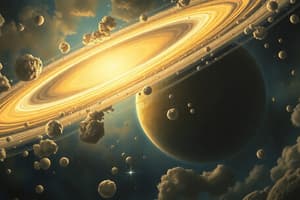Podcast
Questions and Answers
What determines the strength of the gravitational force between two objects?
What determines the strength of the gravitational force between two objects?
- Only the mass of the larger object
- The mass of the objects and the distance between them (correct)
- The velocity of the objects
- The temperature of the objects
What happens to a protostar if it fails to achieve nuclear fusion?
What happens to a protostar if it fails to achieve nuclear fusion?
- It stabilizes as a white dwarf
- It explodes as a supernova
- It becomes a black hole
- It is transformed into a brown dwarf (correct)
Which of the following best describes the main sequence of a star's lifecycle?
Which of the following best describes the main sequence of a star's lifecycle?
- It can last from 10 million to 1 trillion years (correct)
- It can last anywhere from 1 million to 10 million years
- It is the phase when a star is collapsing into a black hole
- It occurs after the star has burned through its hydrogen
How do planets form in the early solar system?
How do planets form in the early solar system?
What is the role of gravity in the formation of round shapes in celestial bodies?
What is the role of gravity in the formation of round shapes in celestial bodies?
What occurs at the end of a low-mass star's life cycle?
What occurs at the end of a low-mass star's life cycle?
What is radial gravitational attraction?
What is radial gravitational attraction?
What shape are elliptical galaxies primarily characterized as?
What shape are elliptical galaxies primarily characterized as?
What is the primary reason for the occurrence of seasons on Earth?
What is the primary reason for the occurrence of seasons on Earth?
What type of galaxy is the Milky Way classified as?
What type of galaxy is the Milky Way classified as?
What phenomenon is described as the process where Earth’s geomagnetic poles flip?
What phenomenon is described as the process where Earth’s geomagnetic poles flip?
What determines orbital eccentricity in planetary orbits?
What determines orbital eccentricity in planetary orbits?
What is a significant feature of the galactic bulge in a galaxy?
What is a significant feature of the galactic bulge in a galaxy?
What is the relationship between a star's temperature and its color?
What is the relationship between a star's temperature and its color?
Which force balances the orbits of planets around the Sun?
Which force balances the orbits of planets around the Sun?
What causes the Sun's rays to be more concentrated during summer in the Northern Hemisphere?
What causes the Sun's rays to be more concentrated during summer in the Northern Hemisphere?
What does the Hertzsprung-Russell (H-R) diagram primarily illustrate?
What does the Hertzsprung-Russell (H-R) diagram primarily illustrate?
What element is NOT typically found in the interstellar medium of a galaxy?
What element is NOT typically found in the interstellar medium of a galaxy?
Which type of galaxy is described as containing a linear bar-shaped pattern of stars?
Which type of galaxy is described as containing a linear bar-shaped pattern of stars?
What are the main components of a galaxy?
What are the main components of a galaxy?
How do giants and supergiants differ from white dwarfs in terms of luminosity?
How do giants and supergiants differ from white dwarfs in terms of luminosity?
What is the significance of absolute visual magnitude?
What is the significance of absolute visual magnitude?
What does Wien's Law state about a blackbody's emitted wavelength?
What does Wien's Law state about a blackbody's emitted wavelength?
Which category of galaxies is considered the oldest among the three main types?
Which category of galaxies is considered the oldest among the three main types?
Why do cooler stars need to be larger to achieve comparable luminosity to hot stars?
Why do cooler stars need to be larger to achieve comparable luminosity to hot stars?
Study Notes
Universal Law of Gravitation
- Newton developed the universal law of gravitation after observing an apple's fall influenced by Earth's gravity.
- Every object in the universe attracts others through its mass.
- Gravity acts radially due to gravitational fields pointing toward an object's center of mass.
- The force of gravity (F) is calculated using the formula F = G(m1*m2)/r², where G is the gravitational constant, m1 and m2 are masses, and r is the distance between their centers.
- Gravity's strength depends directly on mass and inversely on the square of the distance.
- Essential for maintaining orbits of planets and moons, and shaping celestial bodies like stars and planets.
Star Formation
- Stars originate in stellar nebulas, large hydrogen gas clouds.
- A collapsing hydrogen gas forms a protostar, the initial stage of a star.
- Protostars aim to gather enough mass for nuclear fusion to commence; unsuccessful attempts yield brown dwarfs.
- Successful fusion leads to the birth of a star, entering the main sequence lasting 10 million to 1 trillion years.
- Post-main sequence, low-mass stars evolve into red giants and planetary nebulas, while high-mass stars become red supergiants and can explode in supernovae.
Luminosity and Brightness
- Luminosity represents the total energy a star emits per second, distinct from its apparent brightness.
- Absolute visual magnitude assesses intrinsic brightness as if the star were 10 parsecs away; a parsec equates to approximately 3.26 light-years.
- Apparent visual magnitude refers to perceived brightness from Earth.
Stellar Temperature and Color
- Stars are categorized into spectral classes from 2,500K (cool) to 50,000K (hot) based on their temperature.
- Blackbody radiation curves relate intensity to temperature, aiding the classification of stars.
- Wien's Law establishes that hotter stars emit shorter wavelengths, appearing blue, while cooler stars emit longer wavelengths, appearing red.
Hertzsprung-Russell (H-R) Diagram
- The H-R diagram plots stars by luminosity against surface temperature, devised by Hertzsprung and Russell in the early 1900s.
- About 90% of stars are located along the main sequence, indicating stable fusion.
- Characteristics like temperature and luminosity influence a star's size and positioning on the diagram.
Galaxy Structure
- Galaxies consist of massive star clusters encompassing dark matter, gas, and dust, bound by gravity.
- Edwin Hubble's observations identified numerous galaxies beyond the Milky Way; estimates suggest 100-200 billion galaxies in the observable Universe.
- Main galaxy types include spiral, elliptical, and irregular, with subcategories highlighting different structural features.
Types of Galaxies
- Elliptical galaxies vary in shape from circular to oval, classified into grades E0 to E7.
- Spiral galaxies feature spiral arms and a central bulge, which include subtypes like barred spirals and lenticular galaxies.
- Irregular galaxies lack defined shapes and are the smallest and oldest types.
Earth's Motion and Seasons
- Earth orbits the Sun in an elliptical path, with seasonal changes resulting from axial tilt rather than proximity.
- The Giant Impact Hypothesis suggests Earth's axis was tilted 23.4 degrees due to a massive impact during its formation.
- Seasons change because hemispheres tilt toward or away from the Sun, altering sunlight intensity and duration.
Eclipse Events
- Eclipses occur when celestial bodies obstruct light, with solar and lunar eclipses being two main types.
- Solar eclipses happen when the moon passes between Earth and the Sun, while lunar eclipses occur when the moon moves into Earth's shadow.
- Eclipses follow patterns recognized by ancient civilizations, understanding cycles such as the Saros cycle.
Moon Phases and Seasons
- The moon, Earth's natural satellite, reflects sunlight and undergoes orbital phases.
- The new moon phase signifies no visible light, while the full moon displays its entire illuminated surface.
- The moon's orbital cycle influences its appearance from Earth, transitioning through waxing and waning phases.
Studying That Suits You
Use AI to generate personalized quizzes and flashcards to suit your learning preferences.
Description
Explore the principles of Newton's Universal Law of Gravitation and the process of star formation. This quiz covers how gravity shapes the universe and the stages involved in the birth of stars. Test your knowledge on these fundamental concepts in astronomy.




